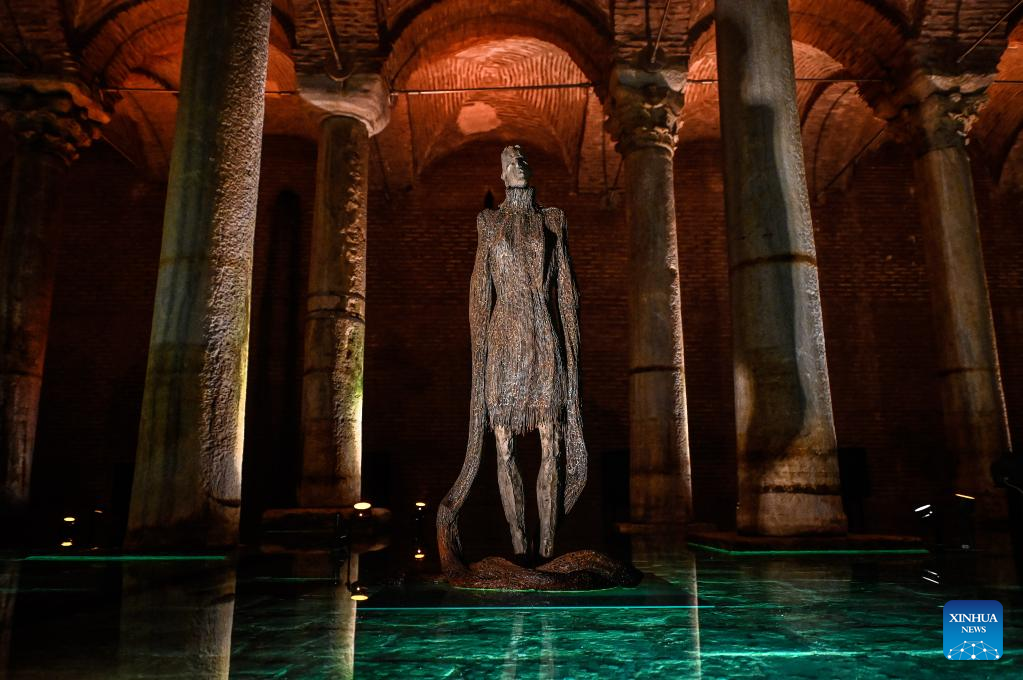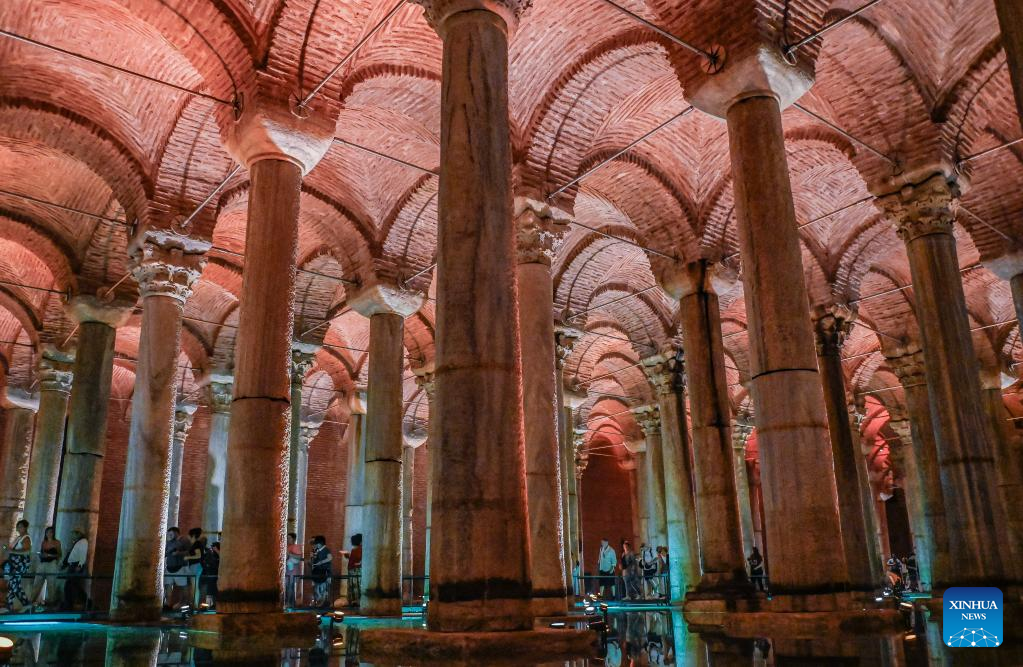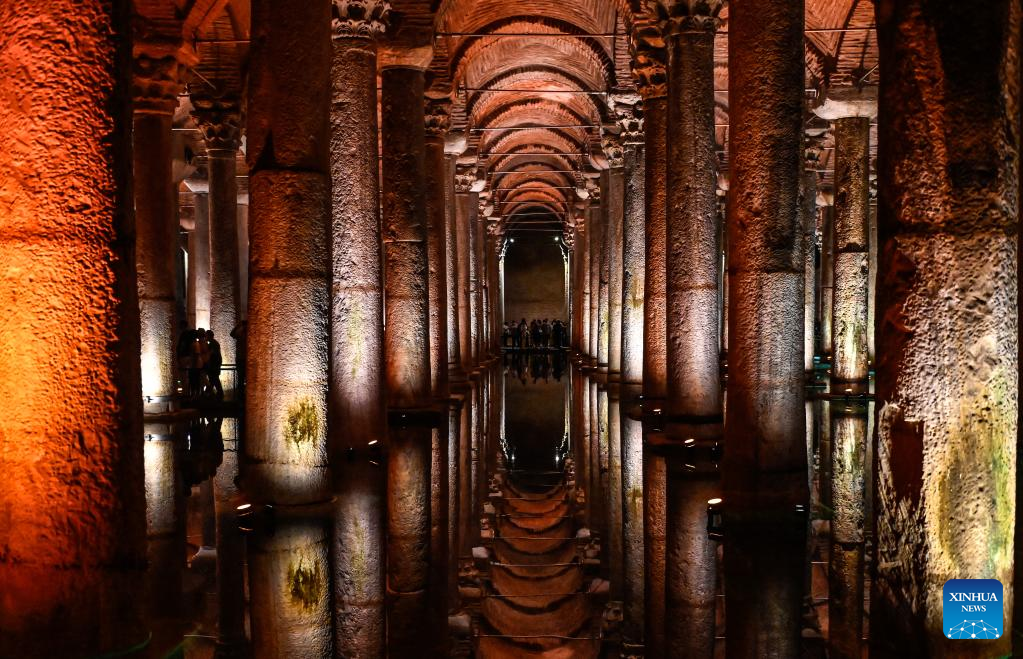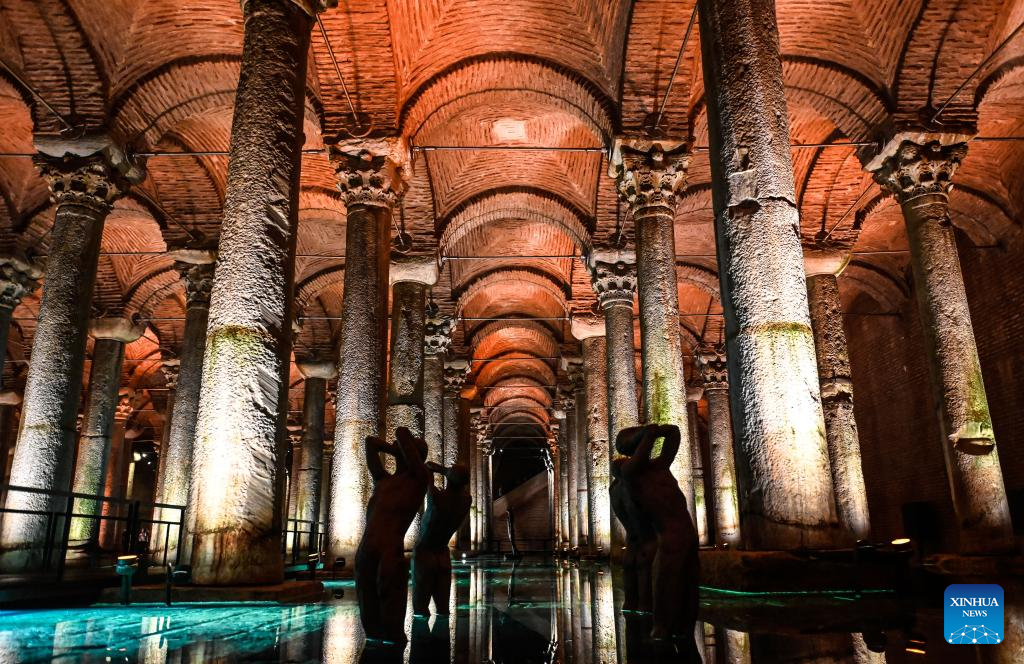
This photo taken on Aug. 29, 2023 shows the Basilica Cistern in Istanbul, Türkiye. After two years of arduous restoration and consolidation, the Basilica Cistern, a 1,500-year-old Byzantine underground reservoir, finally has its hidden beauties and the stories behind its formation brought to light.
Known for a huge underground chamber supported by marble columns, the cistern, also known as the Sunken Palace, is located on the ancient Istanbul peninsula, once the Byzantine Empire's capital.(Photo by Omer Kuscu/Xinhua)
by Zeynep Cermen
ISTANBUL, Aug. 31 (Xinhua) -- After two years of arduous restoration and consolidation, the Basilica Cistern, a 1,500-year-old Byzantine underground reservoir, finally has its hidden beauties and the stories behind its formation brought to light.
Known for a huge underground chamber supported by marble columns, the cistern, also known as the Sunken Palace, is located on the ancient Istanbul peninsula, once the Byzantine Empire's capital.
The cistern spanning over 10,000 square meters was built on the order of Emperor Justinian I, who was desperate to solve the city's water problem, Berk Alparslan, an archaeologist with the Istanbul Municipality Cultural Heritage Department, told Xinhua.
"Justinian, known as the 'Emperor who never sleeps' because of his enthusiastic working habits, wanted the cistern to be completed as soon as possible as Istanbul was under constant threat of drought," said Alparslan, recounting the challenges of the construction of the gigantic structure.
Marble for its columns had to be brought from the nearby island of Marmara.
"However, in the conditions of that time, the boats carrying the marbles were often either sunk or delayed to deliver the loads due to bad weather conditions. The emperor, hurrying to finish the construction, demanded some of the columns to be taken from other structures," he explained.
Following his order, 336 marble columns, collected from across the city and each 9 meters high with distinct stunning Corinthian and Doric-style decorations, came together to support a reservoir of nearly 100,000 tons of water when fully filled.
"Since it was an underground structure, it carried the weight of the city on its columns," Merve Gedik, project director at Istanbul Municipality's Cultural Heritage Department, told Xinhua.
The cistern, however, fell into disuse after the 10th century due to its costly and laborious maintenance, Alparslan said.
Over time, the cistern along with its stories was covered with tons of mud and faded into oblivion among the locals, until it was rediscovered, and later, consolidated several times starting the 18th century.
Following a two-year-long extensive restoration works between 2020 and 2022 led by the municipality, the Sunken Palace has become the city's pearl, luring nearly 15,000 visitors daily, according to Gedik.
After the cleaning works, the beauty of all the columns was revealed and the seals of the brick masters on the Byzantine bricks used in the floor covering were clearly visible, Gedik added.
The two gigantic Medusa heads from the 4th century, which decorate the lower parts of two opposite columns, and a theater mask from the 3rd century on the upper part of another column are the highlights.
The "weeping column" has become another attraction. According to a myth, the patterns of tears carved on the column symbolized the workers' efforts to complete the cistern on time.
"It is truly like an underground forest. Those columns are like trees, and we feel lost in a maze," Gedik marveled. "The fact that it has an atmosphere that isolates us from the world above is what impressed us the most."
In order for the neighborhood to have easy access to water, the Byzantines had also dug wells above the cistern, and the holes from these wells in the ceiling were also revealed in the restoration work, she added.
The cistern, now shrouded in the artistic lighting tailored by Italian lighting designer Adriano Caputo, also hosts contemporary art shows, performances, and concerts. ■

This photo taken on Aug. 29, 2023 shows marble columns at the Basilica Cistern in Istanbul, Türkiye. After two years of arduous restoration and consolidation, the Basilica Cistern, a 1,500-year-old Byzantine underground reservoir, finally has its hidden beauties and the stories behind its formation brought to light.
Known for a huge underground chamber supported by marble columns, the cistern, also known as the Sunken Palace, is located on the ancient Istanbul peninsula, once the Byzantine Empire's capital.(Photo by Omer Kuscu/Xinhua)

This photo taken on Aug. 29, 2023 shows tourists visiting the Basilica Cistern in Istanbul, Türkiye. After two years of arduous restoration and consolidation, the Basilica Cistern, a 1,500-year-old Byzantine underground reservoir, finally has its hidden beauties and the stories behind its formation brought to light.
Known for a huge underground chamber supported by marble columns, the cistern, also known as the Sunken Palace, is located on the ancient Istanbul peninsula, once the Byzantine Empire's capital.(Photo by Omer Kuscu/Xinhua)

This photo taken on Aug. 29, 2023 shows marble columns at the Basilica Cistern in Istanbul, Türkiye. After two years of arduous restoration and consolidation, the Basilica Cistern, a 1,500-year-old Byzantine underground reservoir, finally has its hidden beauties and the stories behind its formation brought to light.
Known for a huge underground chamber supported by marble columns, the cistern, also known as the Sunken Palace, is located on the ancient Istanbul peninsula, once the Byzantine Empire's capital.(Photo by Omer Kuscu/Xinhua)

This photo taken on Aug. 29, 2023 shows marble columns at the Basilica Cistern in Istanbul, Türkiye. After two years of arduous restoration and consolidation, the Basilica Cistern, a 1,500-year-old Byzantine underground reservoir, finally has its hidden beauties and the stories behind its formation brought to light.
Known for a huge underground chamber supported by marble columns, the cistern, also known as the Sunken Palace, is located on the ancient Istanbul peninsula, once the Byzantine Empire's capital.(Photo by Omer Kuscu/Xinhua)

This photo taken on Aug. 29, 2023 shows the Basilica Cistern in Istanbul, Türkiye. After two years of arduous restoration and consolidation, the Basilica Cistern, a 1,500-year-old Byzantine underground reservoir, finally has its hidden beauties and the stories behind its formation brought to light.
Known for a huge underground chamber supported by marble columns, the cistern, also known as the Sunken Palace, is located on the ancient Istanbul peninsula, once the Byzantine Empire's capital.(Photo by Omer Kuscu/Xinhua)



